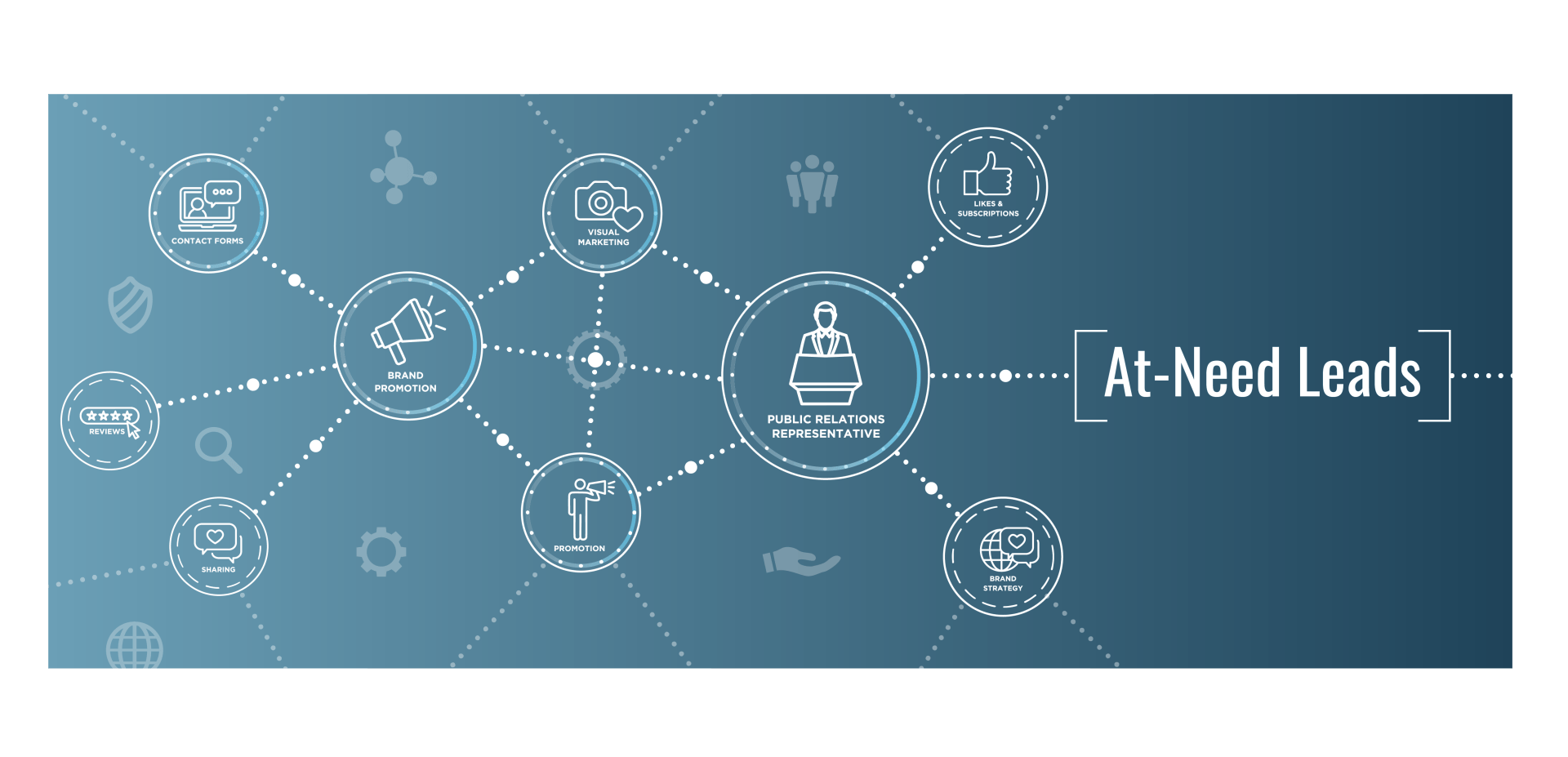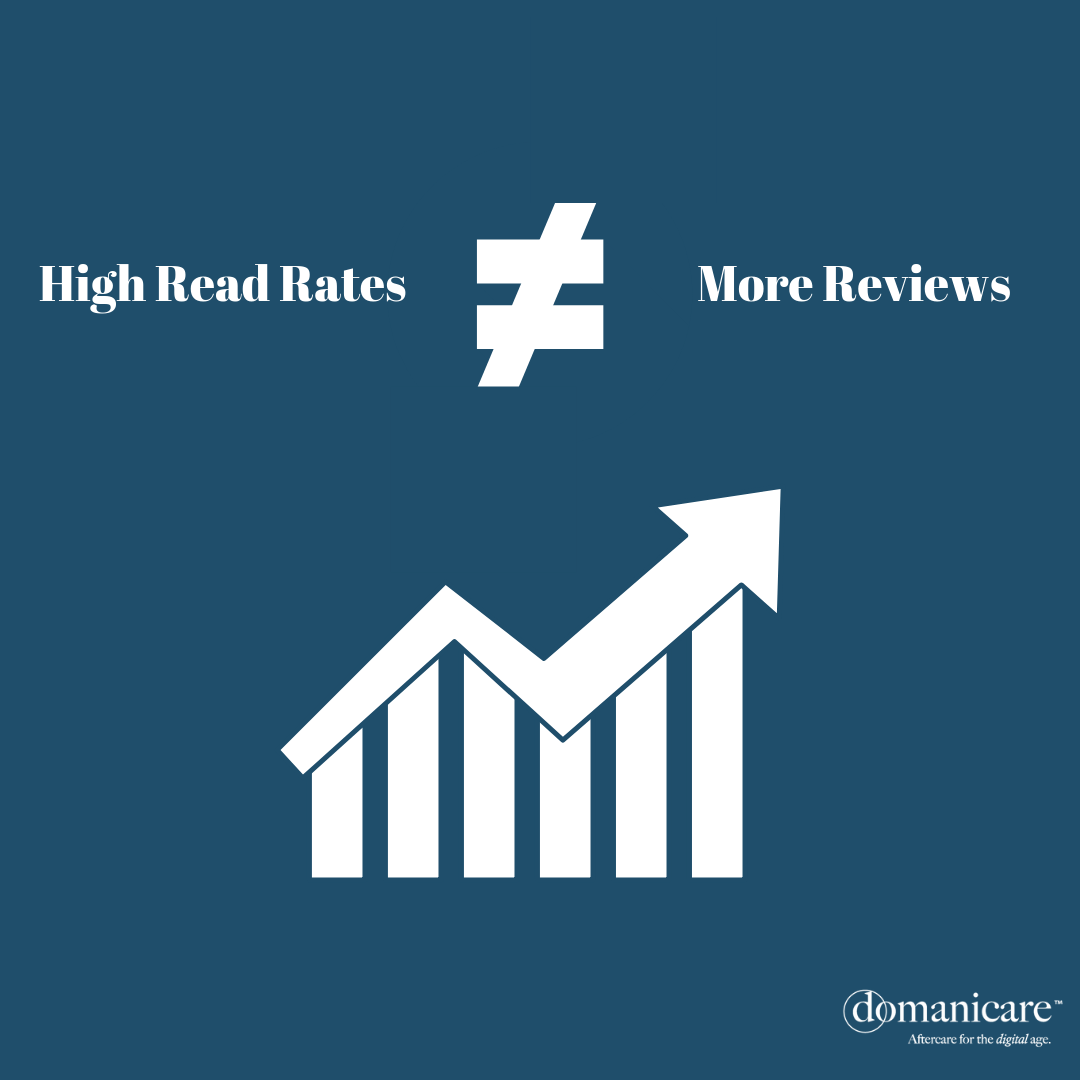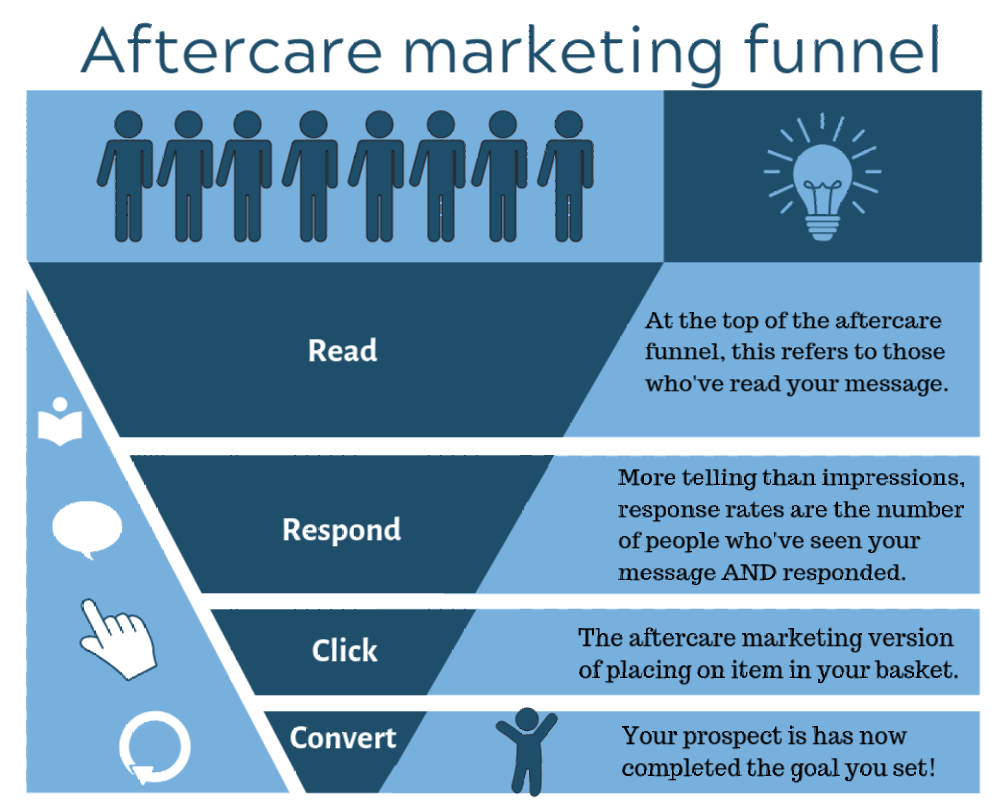Blog Layout
Aftercare Marketing: Why High Read Rates Don't Cut It
Jon Lefrandt • August 5, 2019
Of the statistics that determine the success of any campaign in marketing, read rate is one of the least definitive.

That’s why sending out cards or direct mail as a means of aftercare alone doesn’t cut it.
Although read rates do provide useful information, they should not be the determining factor in selecting one aftercare or marketing service over another.
For example, even though Domanicare has one of the highest read rates
of any aftercare program, we rely on other, more telling statistics to prove our worth.
While we pride ourselves in using an aftercare communication method with a 98% read rate, we prefer to rely on how many positive reviews we generate, how many preneed appointments we set, and how many people we help through grief support.
So what statistics really matter? Which ones determine the success of a marketing or aftercare campaign?
Let’s examine the marketing funnel to discover which data points are the most useful in determining the success of our aftercare program.
The Aftercare Marketing Funnel
What exactly is a marketing funnel?
Single Grain
describes the marketing funnel as “a way of breaking down the customer journey all the way from the “awareness” stage (when they first learn about your business) to the “purchase” stage (when they're ready to buy your product or service).”
Let’s look at an example. The customer journey for a department store has a few stages:
- The customer sees your store.
- They walk into the store.
- They see an item they like.
- They put it in their cart.
- They wait in line.
- They purchase the item.
Saying read rate is the determining factor in the success of your aftercare is like saying that your store is successful because lots of people see it.
The truth is that just because people see your store, it doesn’t mean they’ll walk in, pick an item, put it in their shopping cart, and finally purchase it.
When it comes to your funeral aftercare program, the marketing funnel becomes a means of breaking down the effectiveness of your communication method, the conversations you’re having, the resources you provide to your families, and the number of families who fulfill the goal you’ve set (whether that goal is to set a preneed appointment
or generate a 5-star review).
In order to measure the success and effectiveness of your aftercare program, let’s look at our very own Aftercare Marketing Funnel:
- Read Rate
- Response Rate
- Click-Through Rate (CTR)
- Conversion Rate
Whether it’s a read rate for texting, impressions for social posts, or simply foot traffic for billboards or stores, this is the highest in the funnel, least informative, and the most indeterminate statistic in the funnel (that’s how marketing funnels work — the higher up in the funnel, the wider the gate and the vaguer the data point).
We’ve already reviewed the four stages of the aftercare marketing funnel: Read rate, response rate, click-through rate, and conversion rate.
But which stage is the most important?
The truth is that every stage contributes to the bottom line. And because every company, service, process, and campaign is unique, the efficiency of each individual stage will differ.
That’s why you need to have high read rates, high response rates, AND high click rates in order to have high conversion rates.
However, most of the time, one stage in the marketing funnel underperforms more than the rest. For example, a department store may have a great product selection, wonderful employees, and a wide entrance, but if the store only has one cashier then lines will be long and customers will leave, obliterating their bottom line.
Your aftercare communication reacts in the same way.
The success of your aftercare program
will largely be determined by how well you identify and remedy inefficiencies in your aftercare funnel.
How to Increase the Bottom Line in Your Aftercare Funnel
As we’ve already established, you increase the conversion rate by increasing the success of every part of your sales funnel.
So let’s take a look at each stage of your funeral aftercare program.
Increasing Read Rate
The first and obvious answer to increasing read rates is to send more messages — the higher the total number of messages sent, the more people will read the message. In aftercare, this means you need more at-need customers or you need to collect more phone numbers. Can you collect numbers from multiple individuals from each at-need family?
Besides increasing the total number of messages sent, you should also increase the quality of the messages you’re sending. Message quality includes the number you’re sending from, the message itself, and the time the message is being sent. Use a 10-digit phone number to let your aftercare families know that it’s a personal text from the get-go (5-digit phone numbers are widely regarded as marketing messages and are trusted less).
The message itself should convey sensitivity to the family’s mourning. As funeral directors, nobody knows better than you how to talk to a grieving family. Use these messages as a tool to extend your heartfelt condolences and ask the family member a specific question that begs to be answered. For example, you can ask aftercare families whether they would like another death certificate, any grief resources, or any additional service you can provide.
Overall, your initial message is extremely important, so test the read rates of different messages against each other to find which is most effective.
Increasing Response Rate
The key to response rates on any device or platform is personalized conversations. If you can make an immediate connection with the people you are talking to then they are much more likely to respond to your messages.
Start out by declaring that you are someone that they’ve met and spoken with before. For example, “Hey Sarah, this is Jon from ABC Funeral Home. I spoke with you right after the funeral a few weeks ago...”
The individual will recognize the connection and begin to consider the rest of your message. At this point, express condolences and state quickly the reason for your message, which should be to extend help or resources.
Your call to action (every message campaign should have a call to action) should be immediately recognized as helpful to the aftercare family. If your CTA is to generate positive reviews, you should not ask for a review until you’ve done all you can to help the individual AND they’ve expressed gratitude.
Increasing CTR (Click Through Rate)
Click through rates for mobile text messaging are already much higher than most other communication methods (that’s just one reason we recommend text messaging aftercare). According to CallHub, “the average click through rate for links in SMS messages stands at 19% while the click through rate for e-mail marketing is at 3.2%”
However, if your click through rate is suffering, there may be a few ways to identify the problem.
The first possible problem is the improper placement of links. For example, if you provide the aftercare family with a link to an online grief support resource when the individual has not expressed interest or feels they do not need grief support, they will not click the link. If you ask the individual to leave a review when he or she hasn’t expressed positive feelings about your company, it’s not likely that they will respond. Do not provide links that seem out of place, unsolicited, or inappropriate.
The second possible problem could be a technical issue. If your link is broken, your click through rates will suffer greatly. It is possible that the link you provided may work on your PC, but doesn’t work for mobile devices or tablets. It is also possible that your link will not open in specific browsers. Make sure that your links are clickable on any device.
Increasing Conversion Rate
There are two reasons why all other aftercare metrics determine the success of the conversion rate:
- All other aftercare metrics make up the overall experience. Experience-focused marketing takes into account the entire customer journey from the first to the final step. In the case of a funeral home, this would mean that you examine the experience of aftercare families from the first time they heard about your funeral home or even the moment they’re loved one passed away.
- The number of customers at the first stage determines the number at the end. By way of example, let’s examine how many aftercare families might set a preneed appointment (the goal/conversion stage) if we assume average success rates at each stage with 500 initial text recipients. If you send your initial message to 500 aftercare families and 490 actually see the message (98% read rate), then about 245 will respond (50% average), while 49 individuals click the link you gave them (20% average), and around 24 will convert by leaving a review, setting a preneed appointment, etc. (assuming a 50% average conversion rate). 24 out of the initial 500 recipients might convert as a result of your aftercare campaign assuming averages at each stage. However, quality aftercare programs like Domanicare will see higher than average rates at every stage of the funnel.
You will find that your conversion rate will fluctuate. That’s completely normal; the reason for it is because each time you make a change to your aftercare program, there is a ripple effect through the stages of the funnel. However, the alterations you make to your aftercare marketing should increase the overall experience of your aftercare families.
When you provide quality at-need service and outstanding aftercare resources (grief support, personalized follow-up, appointment setting, etc.), your customers will notice the difference, return to your funeral home, and recommend it to friends and family.
Funeral Home Articles

By Caden Rhoton
•
November 19, 2020
If there's one thing we've learned in 2020, it's that it's difficult to predict the future, and there will all be surprises that lie ahead. Businesses and individuals need to stay agile and adaptable to be ready for whatever life throws at them. 2020 has been a challenging year for the funeral profession and others as well. Still, we've seen that those funeral homes and funeral professionals who have focused on making their consumer experience as comforting and easy as possible are those that are winning. At Domani, we exist to help funeral homes help their families have a better experience. Through the power of text messaging, we follow up with families and give them the support and resources they need following a loss. That great experience then leads to a positive online review and helps others looking for a positive experience to find that funeral home. It's a virtuous cycle that helps grow a funeral home's at-need business. When it comes to preneed, the same principle holds. If funeral homes can provide the experience a family is looking for, that will be the funeral home that wins. During 2020, our preneed appointment setting team has found great success in scheduling remote appointments. Funeral homes that have been willing to adapt and find new ways to do business have grown even during difficult circumstances. We firmly believe that technology will help us as a funeral profession provide those better experiences for families, but simply using technology for technology's sake is not the answer. We need to leverage technology to help provide personal, engaging experiences with families. We shouldn't use technology as a crutch or an excuse. It's another way to help the ones we serve and provide them the support they need during a difficult time. As we approach the end of the year and look forward to 2020, take some time to think about how your funeral home is providing meaningful experiences for families and how/what you can do to improve that in the coming year. If you're interested in learning more about Domanicare or Domani Appoinment Setting, please schedule a demo by clicking the link below.

By Morgyn Carroll
•
September 1, 2020
By far the most effective way to create a sense of loyalty to your funeral home is to perform an exceptional service for that family. However, there’s more that you can be doing to establish credibility with families. Here’s three easy steps on how to develop loyalty to your company and ensure your customers come back for your services when a loved one passes.

By Morgyn Carroll
•
August 28, 2020
The vast majority of people in the US and Canada use smartphones. Almost everyone has a smartphone nowadays. Remember when the first “smartphone” came out in 1992 and cell phones like the BlackBerry and iPhone were considered luxuries when they were first created? Now it’s a common sight to see an iPhone. Most funeral homes and cemeteries haven’t even scratched the surface of text-based aftercare, but with 80% of the U.S. population owning a smartphone, and that number expected to rapidly grow.

